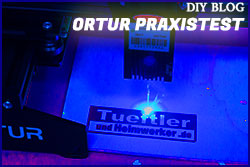Es ging mir nicht um eine exakte Herleitung.Zitat von Manf
Beim Betrachten des Films http://homepage.mac.com/sigfpe/Robotics/equibot.html sieht man, dass die Regelschwingungen für das etwas größere Fahrzeug im Bereich von 2-4Hz liegen. Der Sensor sollte dafür seinen Wert in weniger als 1/3 Periodendauer liefern könen, also in ca. 100ms. Mit etwas mehr Sicherheitsabstand und bei kleinerem Fahrzeug dann vielleicht in 50ms.
Der Sharp-Entfernungsmesser liefert den aktuellen Messwert alle 40ms erkönnte also noch ganz gut und vor allem recht effizient die Neigung messen. Bei der Abstandsmessung zu einem in den Schraubstock eingespannten, mit um 2cm Amplitude vibrierenden Kuststofflineal, liefert er auch für im Bereich von 5-15Hz erfolgenden Abstandsänderungen nachvollziebare Werte. Er scheint damit für die Aufgabe geeignet zu sein.
Höhere Geschwindigkeitsanforderungen bei der Stabilisierung eines ASURO ließen sich auch durch die Vergrößerung des Trägheitsmoments kompensieren.
Manfred








 Zitieren
Zitieren

Lesezeichen